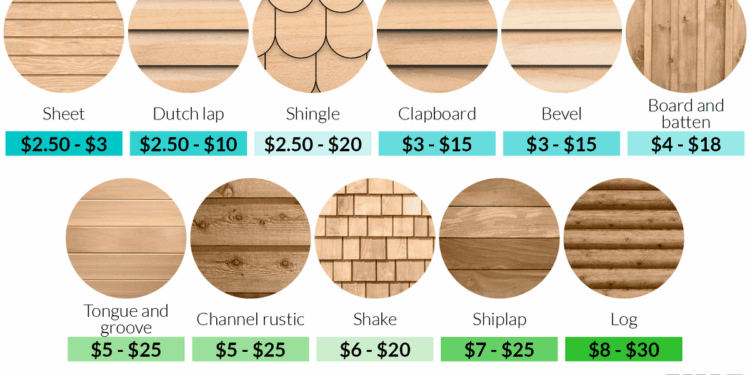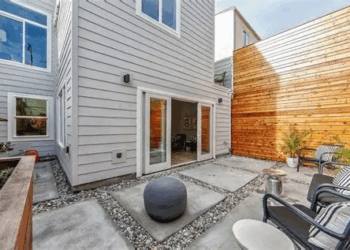
Diving into the realm of house siding options and costs, this introduction aims to captivate readers with a detailed exploration of various materials and expenses involved.
Providing a comprehensive look at the types of siding materials available, their durability, aesthetic appeal, and cost factors, this discussion sets the stage for an informative journey ahead.
House Siding Options
When it comes to selecting the right siding for your home, there are several options available in the market. Each type of siding material has its own unique features and benefits, catering to different needs and preferences.
Vinyl Siding
Vinyl siding is a popular choice among homeowners due to its affordability and low maintenance requirements. It is durable, resistant to rot and insects, and comes in a wide range of colors and styles. However, vinyl siding may not offer the same level of insulation as other materials.
Wood Siding
Wood siding provides a classic and natural look to homes, adding warmth and charm. While wood siding requires more maintenance compared to other materials, it can be easily painted or stained to match your preferred aesthetic. However, wood siding is susceptible to rot, termites, and warping over time.
Fiber Cement Siding
Fiber cement siding is a versatile option that combines the look of wood with the durability of cement. It is resistant to fire, rot, and insects, making it a low-maintenance choice for homeowners. Fiber cement siding is available in various textures and styles, offering versatility in design.
Metal Siding
Metal siding, such as aluminum or steel, is known for its durability and longevity. It is resistant to rot, insects, and fire, making it a robust option for homes in harsh climates. Metal siding can be painted in different colors and finishes, providing a modern and sleek appearance to the exterior of a house.Choose the siding material that best suits your budget, maintenance preferences, and desired aesthetic to enhance the curb appeal and protection of your home.
Cost Factors
When considering house siding options, it is crucial to take into account various cost factors that can significantly impact the overall expense. These factors include the initial installation costs, long-term maintenance expenses, and cost-saving strategies when selecting different siding materials.
Initial Installation Costs vs. Long-Term Maintenance Expenses
The initial installation costs of house siding can vary depending on the material chosen. For example, vinyl siding tends to be more affordable upfront compared to options like fiber cement or wood. However, it is essential to consider the long-term maintenance expenses associated with each material.
While vinyl siding may have lower initial costs, it may require more frequent repairs and replacements over time, ultimately increasing the overall expenses. On the other hand, materials like fiber cement or brick may have higher initial costs but lower maintenance expenses in the long run.
Cost-Saving Strategies
When selecting house siding materials, there are several cost-saving strategies to consider. One approach is to opt for durable materials that require minimal maintenance, reducing the need for frequent repairs or replacements. Additionally, choosing energy-efficient siding options can help lower utility bills over time, providing cost savings in the long term.
Another strategy is to compare quotes from multiple contractors to ensure competitive pricing for both the materials and installation services.
Installation Process
When it comes to installing house siding, there are several general steps involved in the process. Proper installation is crucial to ensure the longevity and effectiveness of the siding on your home.
Importance of Proper Insulation and Waterproofing
- Before installing the siding, it is essential to properly insulate your home. Insulation helps regulate temperature and can improve energy efficiency.
- Waterproofing is also crucial to protect your home from water damage. Proper waterproofing can prevent issues like mold and rot from developing behind the siding.
- Failure to address insulation and waterproofing can result in costly repairs and maintenance down the line.
Common Challenges and How to Address Them
- Uneven surfaces: If your home has uneven surfaces, it can be challenging to install siding properly. One solution is to add furring strips to create a level surface for the siding.
- Moisture issues: Moisture can accumulate behind siding, leading to mold and rot. Proper flashing and installation techniques can help prevent moisture-related problems.
- Inexperienced installers: Hiring inexperienced installers can result in subpar workmanship. Always choose reputable professionals with experience in siding installation to avoid issues.
- Material compatibility: Certain siding materials may not be compatible with existing structures or other materials on your home. It’s essential to consult with a professional to ensure compatibility and proper installation.
Environmental Impact
When it comes to house siding materials, considering the environmental impact is crucial for sustainable living. Each siding option has its own eco-friendliness, and understanding these factors can help homeowners make environmentally conscious choices.
Eco-Friendliness of Different Materials
Here is an analysis of the eco-friendliness of popular house siding materials:
- Vinyl Siding: Vinyl siding is not biodegradable and can release toxic chemicals during production and disposal.
- Fiber Cement Siding: Fiber cement siding is made from recyclable materials like wood pulp and cement, making it a more sustainable option.
- Wood Siding: Wood siding can be sustainable if sourced from responsibly managed forests or reclaimed wood.
- Aluminum Siding: Aluminum siding is highly recyclable and energy-efficient to produce.
Sustainability Features of Popular Siding Options
Popular siding options like fiber cement and aluminum have sustainable features that contribute to reducing the environmental impact:
- Fiber Cement: Fiber cement siding often contains recycled content and is energy-efficient to produce, reducing the overall carbon footprint.
- Aluminum: Aluminum siding is highly recyclable, which means it can be reused or repurposed instead of ending up in landfills.
Reducing Environmental Footprint
Choosing sustainable siding options can significantly reduce the environmental footprint of a home by minimizing waste, energy consumption, and greenhouse gas emissions:
- Energy Efficiency: Energy-efficient siding materials can help reduce heating and cooling costs, lowering the home’s overall energy consumption.
- Recyclability: Opting for recyclable siding materials ensures that the products can be reused or recycled at the end of their lifespan, reducing waste.
- Recycled Content: Siding options with recycled content reduce the demand for new raw materials, contributing to a more circular economy.
Closing Summary
In conclusion, the discussion on house siding options and costs sheds light on the importance of understanding the different materials available, their installation processes, and their environmental impact. By making informed decisions, homeowners can enhance the beauty, durability, and sustainability of their homes.
Essential FAQs
What are some cost-saving strategies when selecting house siding materials?
Opting for materials with lower maintenance requirements and longer lifespans can help reduce costs in the long run.
How important is proper insulation during the siding installation process?
Proper insulation not only improves energy efficiency but also helps prevent moisture-related issues in the future.
What are some common challenges homeowners may face during siding installation?
Challenges can include weather delays, structural issues, and ensuring proper alignment of the siding panels.














